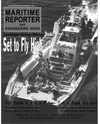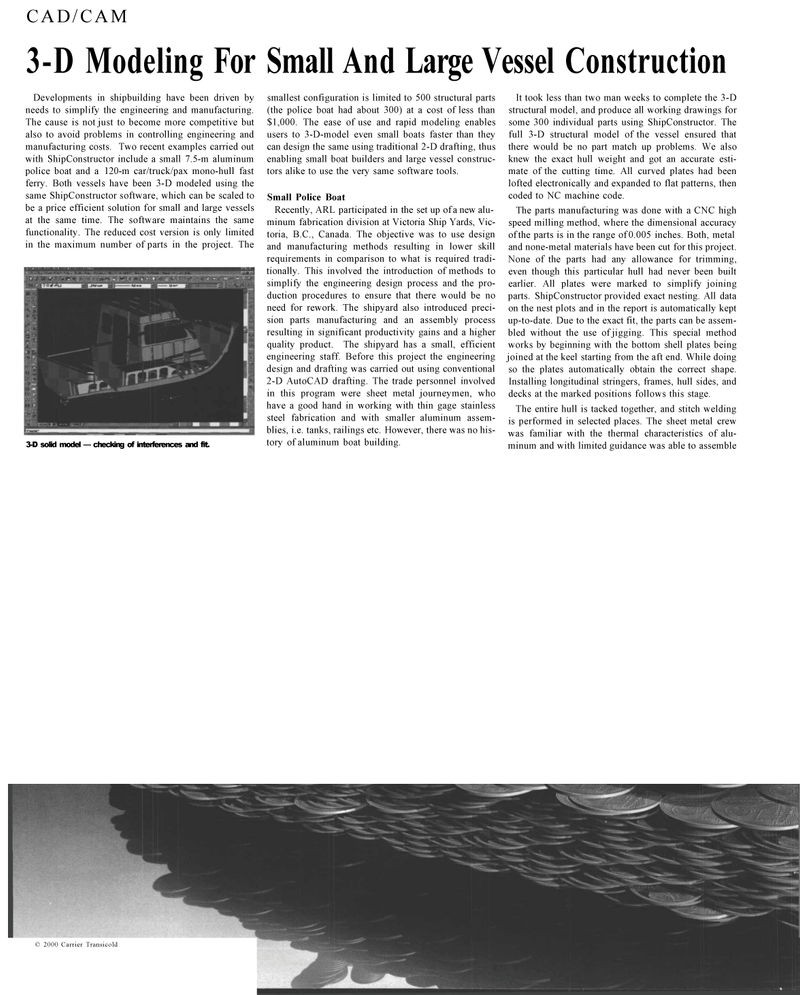
Page 36: of Maritime Reporter Magazine (January 2001)
Read this page in Pdf, Flash or Html5 edition of January 2001 Maritime Reporter Magazine
CAD/CAM 3-D Modeling For Small And Large Vessel Construction
Developments in shipbuilding have been driven by needs to simplify the engineering and manufacturing.
The cause is not just to become more competitive but also to avoid problems in controlling engineering and manufacturing costs. Two recent examples carried out with ShipConstructor include a small 7.5-m aluminum police boat and a 120-m car/truck/pax mono-hull fast ferry. Both vessels have been 3-D modeled using the same ShipConstructor software, which can be scaled to be a price efficient solution for small and large vessels at the same time. The software maintains the same functionality. The reduced cost version is only limited in the maximum number of parts in the project. The 3-D solid model — checking of interferences and fit. smallest configuration is limited to 500 structural parts (the police boat had about 300) at a cost of less than $1,000. The ease of use and rapid modeling enables users to 3-D-model even small boats faster than they can design the same using traditional 2-D drafting, thus enabling small boat builders and large vessel construc- tors alike to use the very same software tools.
Small Police Boat
Recently, ARL participated in the set up of a new alu- minum fabrication division at Victoria Ship Yards, Vic- toria, B.C., Canada. The objective was to use design and manufacturing methods resulting in lower skill requirements in comparison to what is required tradi- tionally. This involved the introduction of methods to simplify the engineering design process and the pro- duction procedures to ensure that there would be no need for rework. The shipyard also introduced preci- sion parts manufacturing and an assembly process resulting in significant productivity gains and a higher quality product. The shipyard has a small, efficient engineering staff. Before this project the engineering design and drafting was carried out using conventional 2-D AutoCAD drafting. The trade personnel involved in this program were sheet metal journeymen, who have a good hand in working with thin gage stainless steel fabrication and with smaller aluminum assem- blies, i.e. tanks, railings etc. However, there was no his- tory of aluminum boat building.
It took less than two man weeks to complete the 3-D structural model, and produce all working drawings for some 300 individual parts using ShipConstructor. The full 3-D structural model of the vessel ensured that there would be no part match up problems. We also knew the exact hull weight and got an accurate esti- mate of the cutting time. All curved plates had been lofted electronically and expanded to flat patterns, then coded to NC machine code.
The parts manufacturing was done with a CNC high speed milling method, where the dimensional accuracy of the parts is in the range of 0.005 inches. Both, metal and none-metal materials have been cut for this project.
None of the parts had any allowance for trimming, even though this particular hull had never been built earlier. All plates were marked to simplify joining parts. ShipConstructor provided exact nesting. All data on the nest plots and in the report is automatically kept up-to-date. Due to the exact fit, the parts can be assem- bled without the use of jigging. This special method works by beginning with the bottom shell plates being joined at the keel starting from the aft end. While doing so the plates automatically obtain the correct shape.
Installing longitudinal stringers, frames, hull sides, and decks at the marked positions follows this stage.
The entire hull is tacked together, and stitch welding is performed in selected places. The sheet metal crew was familiar with the thermal characteristics of alu- minum and with limited guidance was able to assemble © 2000 Carrier Transicold

 35
35

 37
37
